The Pionus parrot often flies under the radar compared to flashier species like Amazons or Cockatoos. These shy, stocky birds from Central and South America boast subtle plumage that shimmers with jewel tones under bright light, revealing their true beauty. If you’re seeking a Pionus parrot companion that’s intelligent, gentle, and relatively quiet, this guide uncovers why they’re an excellent choice for dedicated owners. For more on good birds for pets, check our related insights.
 Kobe the Blue-headed Pionus parrot greeting with a cheerful expression
Kobe the Blue-headed Pionus parrot greeting with a cheerful expression
Initially overlooked as “wallflowers,” Pionus parrots surprise with massive personalities. Owners like those of Kobe, a Blue-headed Pionus, often reduce work hours to spend more time with these engaging chatterboxes. With a lifespan of 30-40 years under proper care, they’re a long-term commitment worth every moment.
Origins of the Pionus Parrot
Pionus parrots hail from northern Mexico through northern Argentina, thriving in diverse habitats. Recognizable by their dark doe eyes and distinctive red triangular vent patch—earning them the old name “Red Vented Parrots”—they’re stocky with short tails. As relatively new to aviculture, their full lifespan potential is still being observed, but good husbandry promises decades of companionship.
 Jabba, a Maximilian’s Pionus female, displaying the red vent splash
Jabba, a Maximilian’s Pionus female, displaying the red vent splash
Pionus Parrot Species Overview
Eight Pionus parrot species exist, with Maximilian’s, Blue-headed, and White-capped most common as pets in places like England. Bronze-winged are gaining traction, while Dusky are more U.S.-popular. Scarcer Coral-billed focus on breeding programs, and Plum-crowned and White-headed remain challenging for captivity.
Larger species like Maximilian’s and Coral-billed reach 29cm and 225-260g, while smaller White-capped and Dusky top out at 24cm and 185-220g. Each offers unique appeal for Pionus parrot enthusiasts.
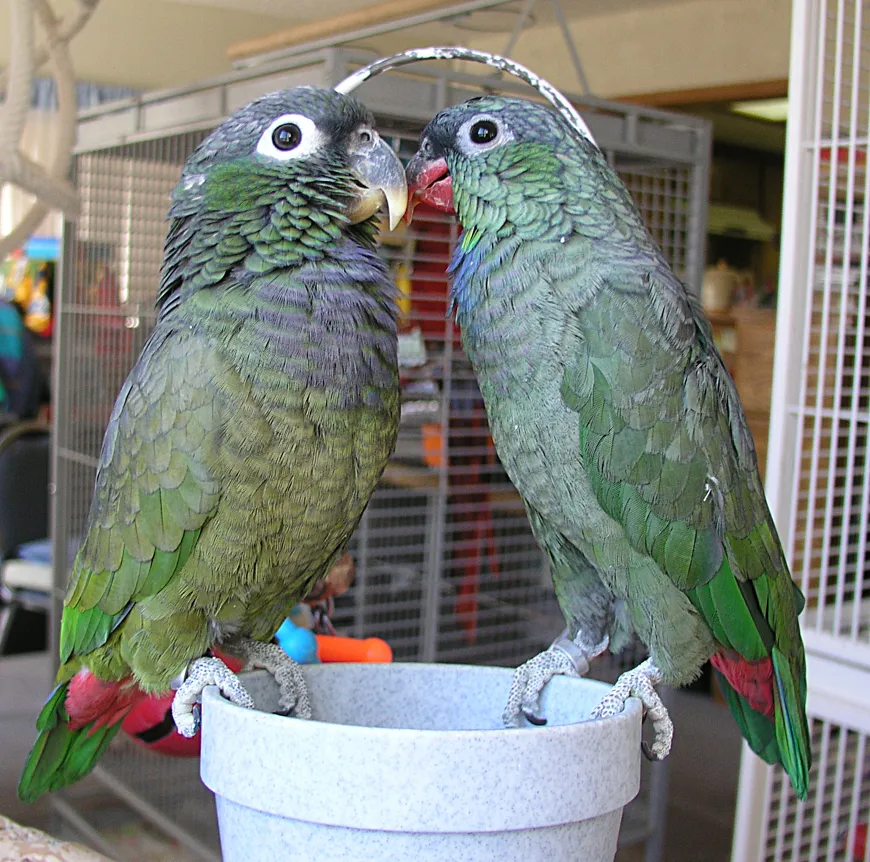 Bentley the Maximilian’s male and Puff the Coral-billed female side by side
Bentley the Maximilian’s male and Puff the Coral-billed female side by side
Personality and Characteristics
Pionus parrots shine in intelligence and curiosity, craving human interaction over solo observation. They’re hands-on but not overly cuddly like Cockatoos—preferring head scratches in calm moments. They bond deeply with one person yet tolerate households well. Expert Roger Sweeney likens them to consistent, less aggressive Amazons.
White-capped and Dusky earn “feisty” reputations, especially males, but owners adore their boldness. Females tend gentler, though males like Kobe prove loving and playful without high energy. As Russ Shade notes, species-specific traits vary individually, making every Pionus parrot unique.
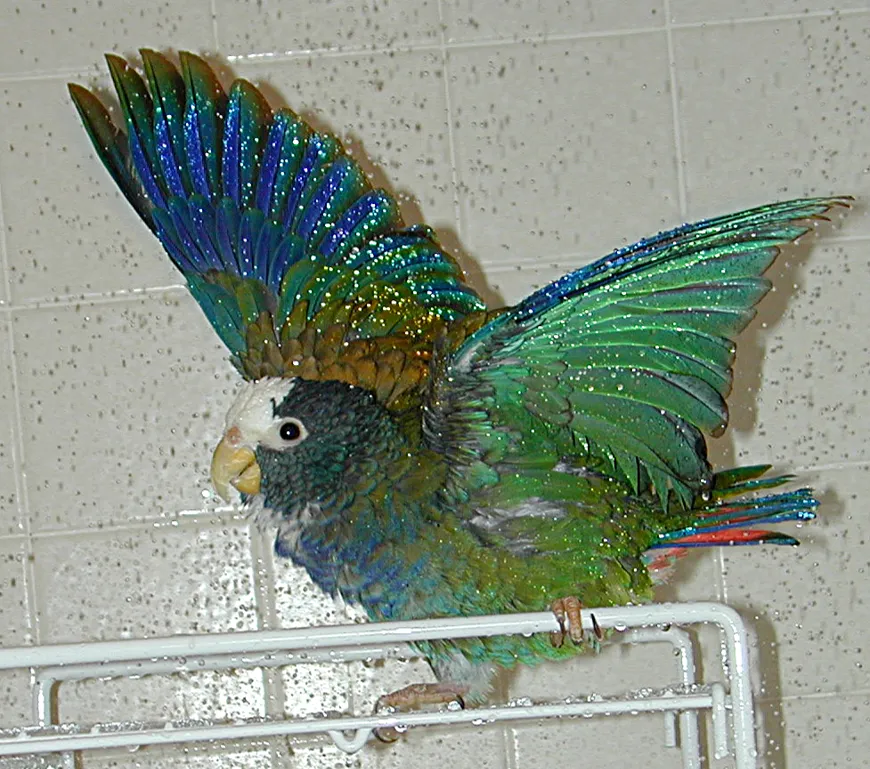 Poirot the White-capped female Pionus showcasing iridescent feathers during a shower
Poirot the White-capped female Pionus showcasing iridescent feathers during a shower
They’re adaptable, mirroring human energy—ideal for harmonious homes. For tips on friendliest birds, explore our guides.
 Punky Rose, a Dusky Pionus female, displaying vibrant personality
Punky Rose, a Dusky Pionus female, displaying vibrant personality
Noise Levels and Talking Ability
Pionus parrots are quieter than many parrots but can rival a vacuum cleaner when excited. Dawn and dusk choruses celebrate life, amplified in lively households. Their raspy voices mimic Greys less perfectly, yet top talkers like male Maximilian’s and Blue-headed build impressive vocabularies. Females excel at tricks, per breeder Ray Dorge.
 Bronson the Bronze-winged female Pionus playing energetically on a skateboard
Bronson the Bronze-winged female Pionus playing energetically on a skateboard Ofoti, a Maximilian’s male Pionus, highlighting talking potential
Ofoti, a Maximilian’s male Pionus, highlighting talking potential
Body Language and Behaviors
Similar to Amazons, Pionus parrot cues are consistent—respect them to avoid bites. They expertly read human moods, reflecting anger or excitement. Unique traits include:
- Puberty (18-24 months): Increased territoriality, vocalizing, nesting urges. Males strut boldly; females cluck or lay infertile eggs. Stay consistent, remove hidey-holes.
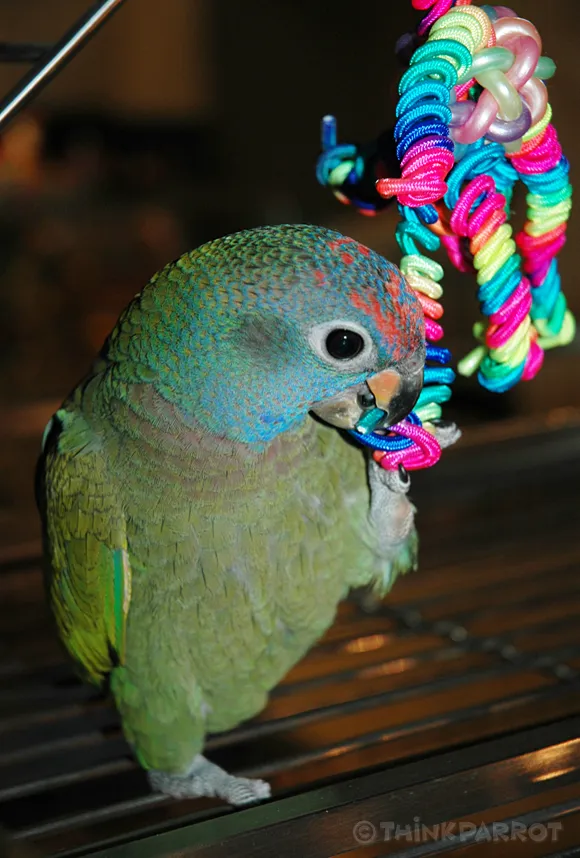 Baby Kobe the Blue-headed Pionus in juvenile plumage at 4 months
Baby Kobe the Blue-headed Pionus in juvenile plumage at 4 months
- Pionus Strut: Male-dominated warning—lowered head, puffed body, flared tail. Observe, don’t touch.
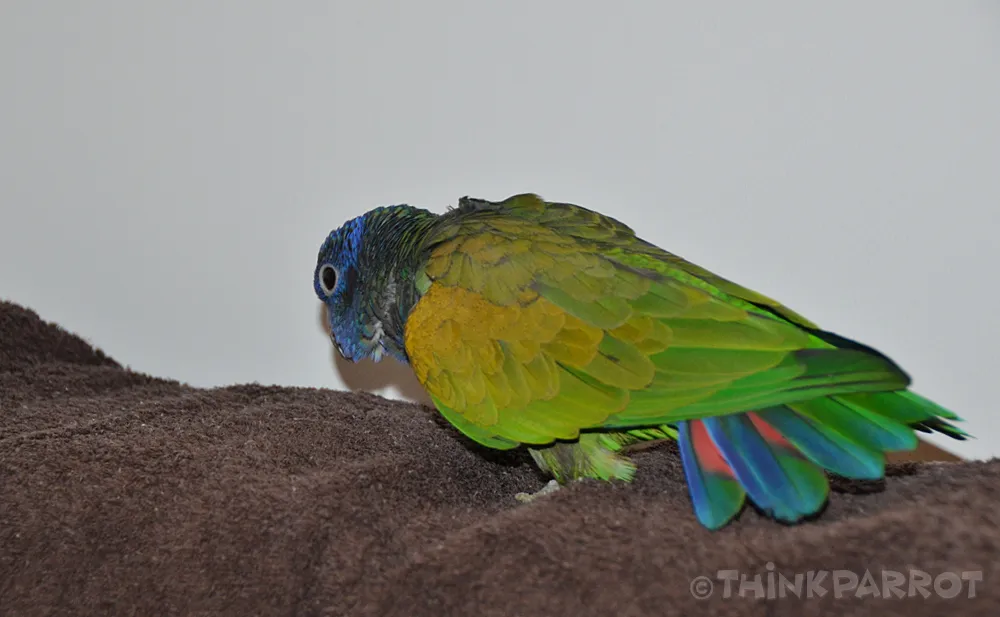 Kobe demonstrating the classic Pionus strut behavior
Kobe demonstrating the classic Pionus strut behavior
Wheeze: Excited or stressed breathing, like an asthmatic train—normal, not respiratory illness.
Freeze: Stress response; gently remove triggers.
Aroma: Species-specific scents from the head, possibly for wild insect attraction.
Dander: No uropygial gland; use feather dust and baths.
Vacuum noise triggers ecstatic showers, mimicking rainforest rains.
 Poirot the White-capped female enjoying a shower, revealing jewel tones
Poirot the White-capped female enjoying a shower, revealing jewel tones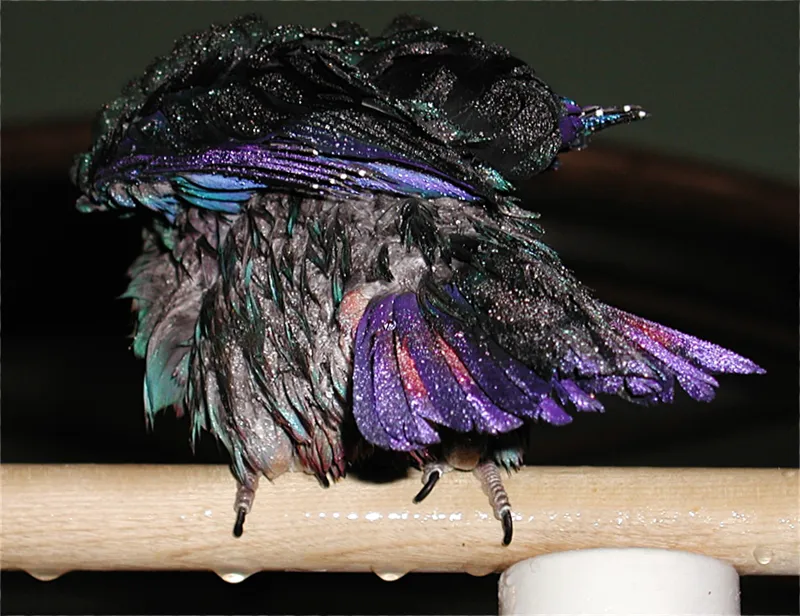 Punky Rose the Dusky female shining in shower colors
Punky Rose the Dusky female shining in shower colors
Housing, Toys, and Flight
Opt for spacious cages (e.g., 34”x24”x36” with 1” bars; smaller for light birds). External feeders suit territoriality. Rotate chewable toys (balsa, cork, plastics, foot toys). They’re powerful half-wing flyers—avoid clipping young birds to prevent muscle issues, as Greg Glendell advises.
 Cosmo the White-capped male Pionus with a vegetable-dyed toy stick
Cosmo the White-capped male Pionus with a vegetable-dyed toy stick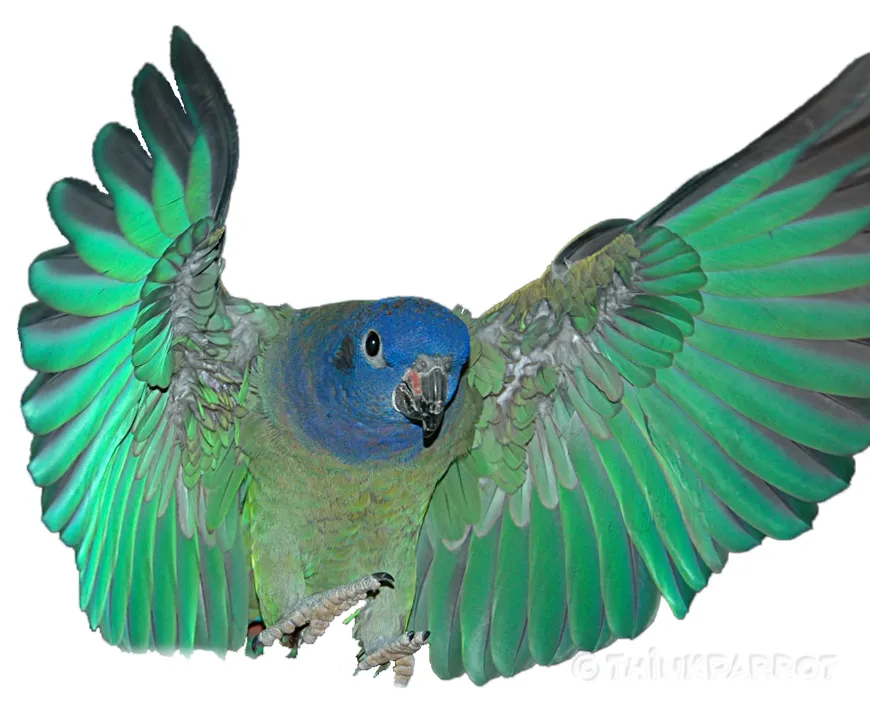 Kobe the Blue-headed male landing gracefully in flight
Kobe the Blue-headed male landing gracefully in flight
Optimal Diet for Pionus Parrots
Prioritize fresh veggies/fruits (broccoli, peppers, berries—avoid avocado, rhubarb, star fruit), sprouts (chickpeas, sunflower), pellets (Harrison’s, Roudybush). Wild Maximilian’s average 15-20% protein; captives need less due to sedentary life. Watch Vitamin A (check choanal papillae), calcium, D—consult avian vets before supplements.
Mash cooked grains/legumes (2:1) with beta-carotene veggies, flax oil. Limit nuts (almonds, walnuts) to combat obesity; skip peanuts.
 Typical breakfast bowl for Pionus parrot with fresh fruits, veggies, and sprouts
Typical breakfast bowl for Pionus parrot with fresh fruits, veggies, and sprouts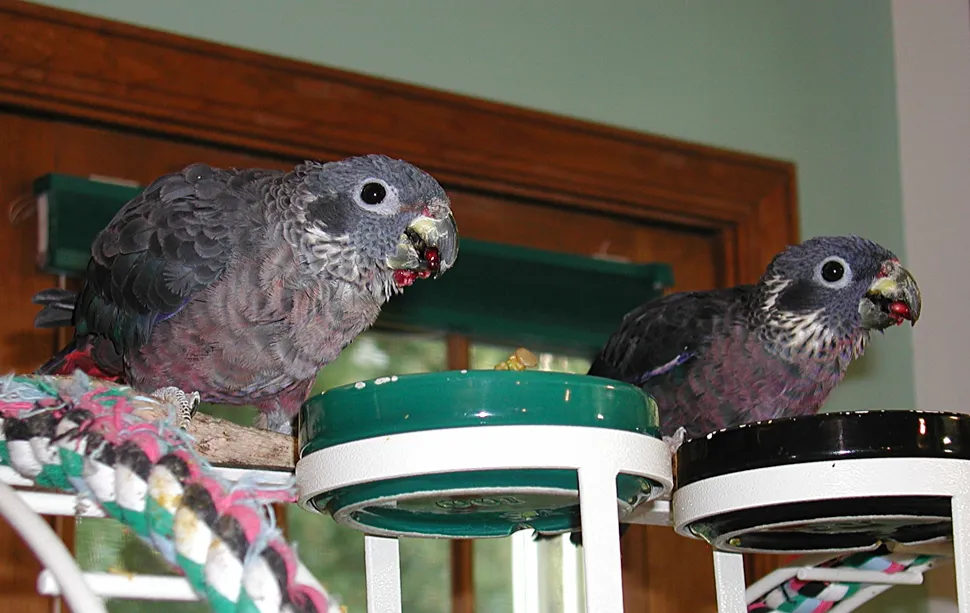 Punky Rose and Raspberry Dusky Pionus enjoying pomegranate
Punky Rose and Raspberry Dusky Pionus enjoying pomegranate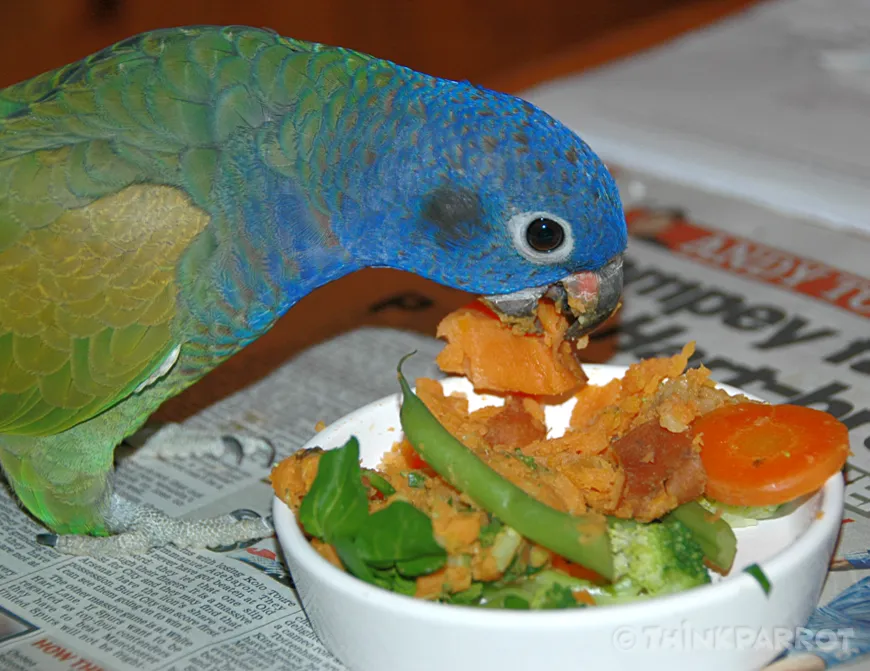 Kobe eating a nutrient-rich evening meal with beta carotene foods
Kobe eating a nutrient-rich evening meal with beta carotene foods
For broader household birds options, see our recommendations. Interested in best parrots for beginners? Pionus top the list.
Health Concerns: Preventing Disease
Good diet and hygiene minimize risks like Aspergillosis (fungal respiratory issue from spores in dirty areas or peanuts). High-altitude origins may sensitize them; avoid antibiotics/steroids overuse. Regular avian vet checks ensure health.
Why Choose a Pionus Parrot?
Entertaining, loyal, and bold, Pionus parrots captivate hearts—no wallflowers here. They’re perfect for experienced owners seeking a unique bond.
Pionus Parrot Species Profiles
Maximilian’s Pionus (Pionus maximilianii)
Scaly-headed with purple throat, green body. Beak yellow-grey; eye rings white-grey.
 Ofoti the Maximilian’s male Pionus in detail
Ofoti the Maximilian’s male Pionus in detail
Blue-headed Pionus (Pionus menstruus)
Cobalt head/chest, green body, blackish beak with pink patches.
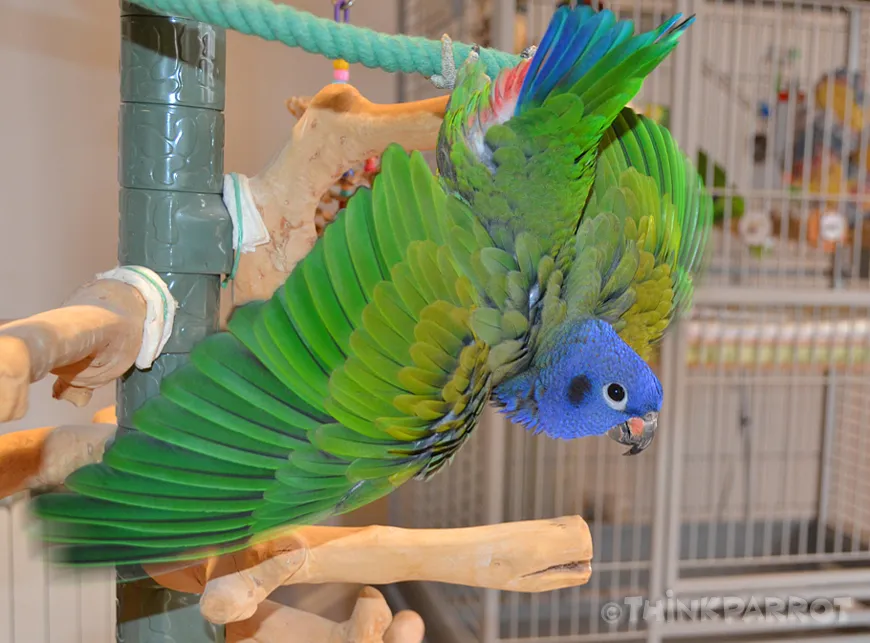 Kobe the mature Blue-headed male Pionus
Kobe the mature Blue-headed male Pionus
White-capped Pionus (Pionus senilis)
Green head with white cap, olive chest, yellow beak.
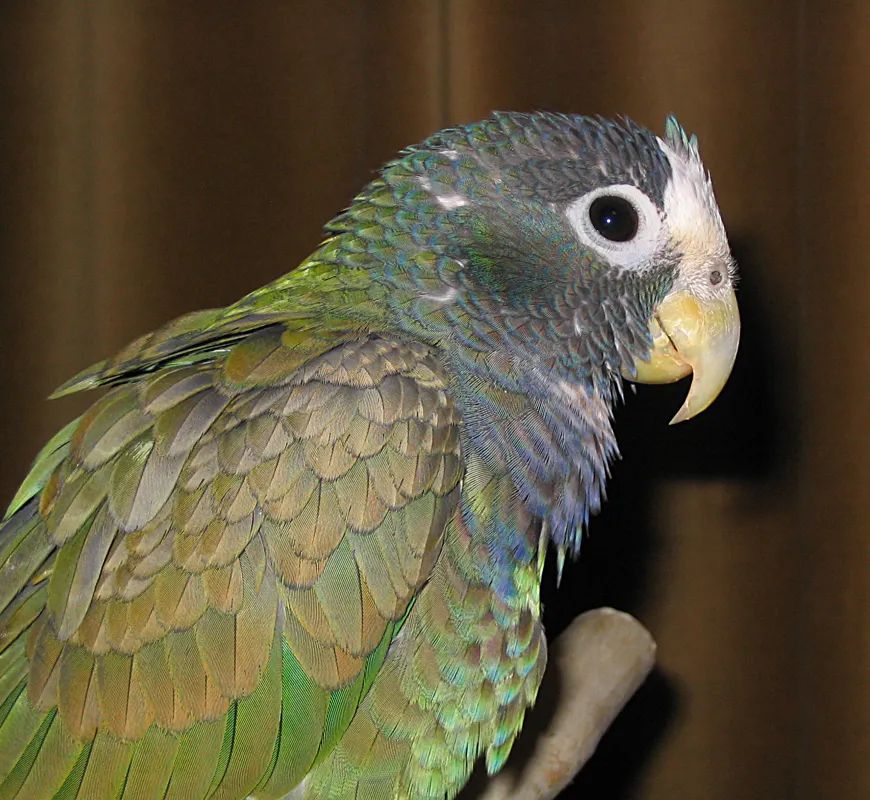 Cosmo the White-capped male Pionus portrait
Cosmo the White-capped male Pionus portrait
Bronze-winged Pionus (Pionus chalcopterus)
Violet-blue with bronze wings, pink throat.
 Bronson the Bronze-winged female hanging playfully
Bronson the Bronze-winged female hanging playfully
Dusky Pionus (Pionus fuscus)
Hawk-like slate head, pink chest, dark wings.
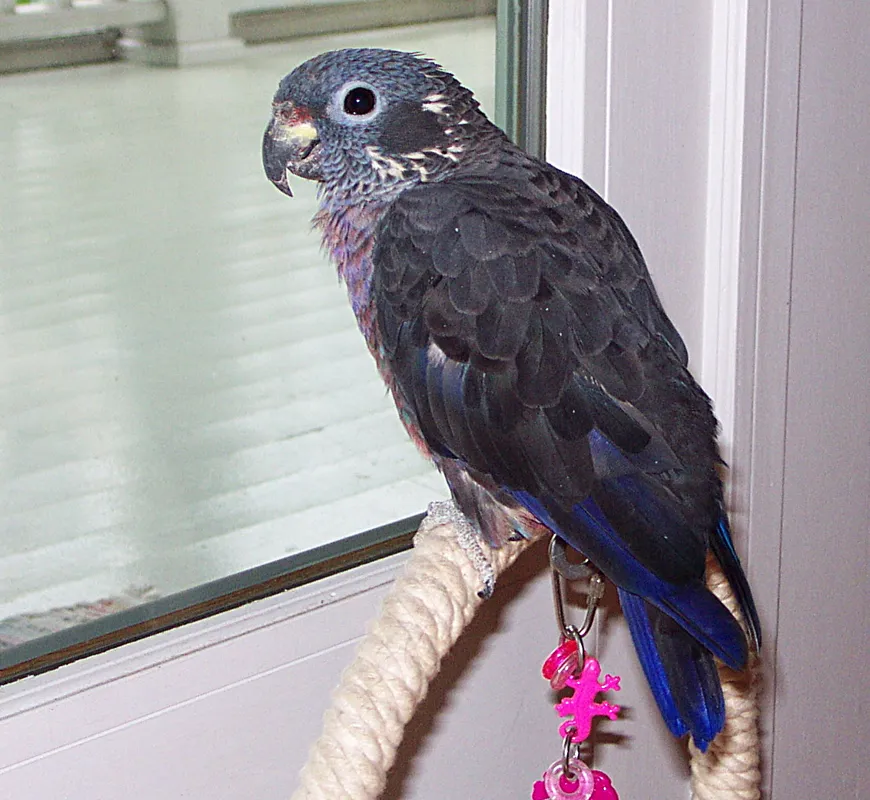 Binah-Lu the Dusky female Pionus close-up
Binah-Lu the Dusky female Pionus close-up
Coral-billed Pionus (Pionus sordidus)
Olive green with purple band, coral beak.
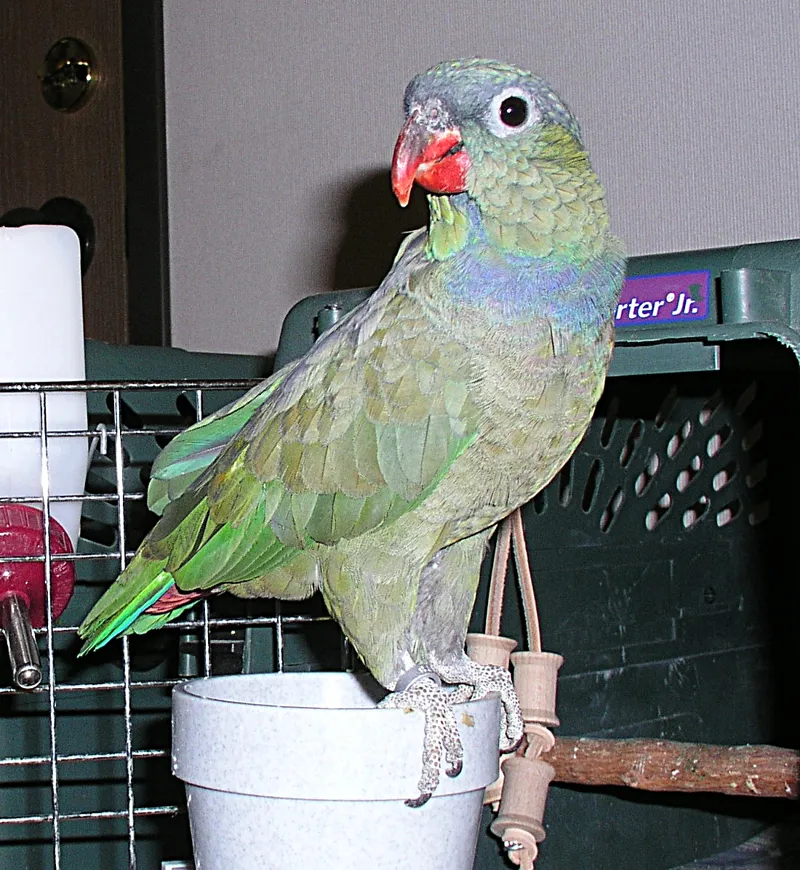 Puff the Coral-billed female Pionus
Puff the Coral-billed female Pionus
Embrace a Pionus parrot for its charm and quirks—consult avian experts for personalized care. Ready to welcome one home? Share your experiences or explore more pet bird guides!
References
- The Practical Pionus by Russ Shade: www.the-practical-pionus.com
- Pionus Parrots: A Complete Guide by Roger G. Sweeney
- Greg Glendell: www.greg-parrots.co.uk
- Dr. Amy Zhao: https://www.thebudgieacademy.com/
- Originally published in Parrots Magazine (Jan 2010, Issue 144); updated April 2024.
